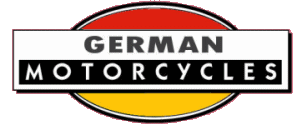


Triumph, BMW, & Kawasaki Sales Spares & Repairs.
Established for over 40 years and run by expert motorcyclists.
Fully authorised workshop.


Bison 1924
This model features a 688cc "Super Six" Coventry Eagle engine. Other models used both SMW and BMW HO Twins.

The enclosed gate change. Lucas switchboard, and the enclosed speedometer drive of th A.B.C.
Luego de finalizada la Primer Guerra Mundial la industria motociclística alemana recobró su posición predominante en Europa, así fue que entre 1922 y 1925 surgieron más de un centenar de pequeñas fábricas de motos…. aunque casi todas ellas desaparecerían al final de esa década con la crisis generada en el país por la hiperinflación.
Alrededor de 1919 la firma Bosch adquiere la licencia para fabricar los motores Douglas utilizados en la Primera Guerra Mundial. La fábrica encargada de construir los motores Bosch-Douglas era la SMW (Stockdorfer Motorenwerke AG) situada en Stockdorf, cerca de Munich que serían ampliamente utilizados como motores estacionarios y también en motocicletas ensambladas por varias fabricas de la zona aledaña a Munich. Además fue el diseño en el que se basaron para construir sus primeros motores boxer los alemanes de D-Rad y de BMW (el modelo M2B15 de 493 cc inicialmente presentado en la Helios diseñada por el Dr. Karl Rühmer para BMW). Los motores Bosch-Douglas de 293 cc y 398 cc SV se colocaban en forma longitudinal al cuadro y entre las marcas que lo usaron estaban Astra (1923-25), Bayern (1923-26), la austriaca Bison (1924–26), Bravis (1924-26), la Hirsch (1923-24) con su inusual cuadro de madera, la Karü ensamblada en la propia SMW de Karl Rühmer (1922-24), KRS (1921-26), Linster (1922-24) y SBD (1923-24).
Posteriormente muchas de ellas también utilizarían el motor M2B15 de BMW, al igual que otras marcas como Victoria, Corona, Helle y KR (sucesora de Karü). Para los fanáticos de BMW que creen que ellos tuvieron en 1923 la idea original de montar el motor en forma transversal al cuadro en su modelo R32 y de esa manera solucionar los problemas de recalentamiento que sufrían los modelos anteriores les comento que ya en 1919, la inglesa ABC (fabricada por la Sopwith Aviation & Engineering y luego desarrollada por la francesa Gnome & Rhone) fue la primer moto con motor boxer transversal. El motor diseñado por Granville Bradshaw era un cuatro tiempos de 398 cc OHV, caja de cambios de 4 velocidades y transmisión final a cadena.
After the First World War the German motorcycle industry strived to regain its predominant position in Europe. Between 1922 and 1925 more than a hundred small motorcycle factories emerged, although almost all of them would disappear before the end of the decade with the financial crisis which resulted in hyperinflation.
Around 1919 the Bosch firm acquired the license to manufacture Douglas engines used in the First World War. The factory responsible for building the Bosch-Douglas engines was SMW (Stockdorfer Motorenwerke AG) located in Stockdorf, near Munich. These were widely used as stationary engines, and also in motorcycles assembled by several factories in the area around Munich. It was also the design on which they based the first German boxer engines which were fitted to D-Rad and BMW. The BMW model M2B15 of 493 cc initially presented in the Helios was designed by Dr. Karl Rühmer for BMW.
The Bosch-Douglas side-valve engines of 293cc and 398cc were placed longitudinally in the frame and among the brands that used these were Astra (1923-25), Bayern (1923-26), the Austrian Bison (1924-26), Bravis (1924-26), the Hirsch (1923-24) with its unusual wooden frame, the Karü assembled at SMW by Karl Rühmer (1922-24), KRS (1921-26), Linsner (1922-24)(1) and SBD (1923-24).
Later many of them would also use the BMW M2B15 engine, as well as other brands such as Victoria, Corona, Helle and KR (Karü's successor).
For BMW fans who believe that the original idea of of mounting the engine transversely to the frame in its 1923 R32 model, thus solving the problem of overheating suffered by previous models, it should be noted that as early as 1919 the English ABC (manufactured by Sopwith Aviation & Engineering and then developed by the French company Gnome & Rhone) was the first motorcycle with a transverse boxer twin. The engine designed by Granville Bradshaw was a four-stroke 398cc OHV using a 4-speed gearbox and final drive by chain.
Source: Sergio Scalerandi
Notes
1. Linster is referred to as Linsner in Henshaw.
2. SMW were the initials of a motorcycle shop based in Wentworth Ave Sydney with branches in Petersham, Liverpool and Penrith active from 1978 to about 2005.
If you have a query or information about SMW engines please contact us